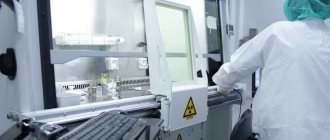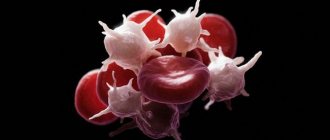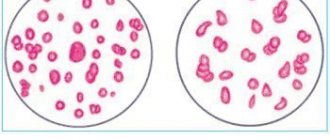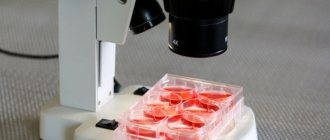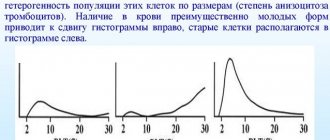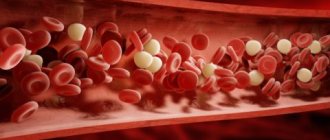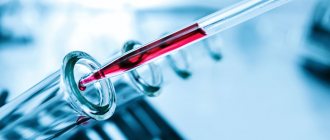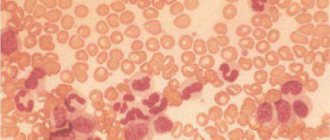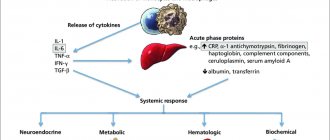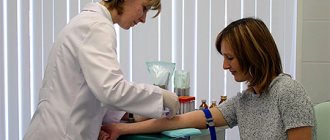What is MID?
Leukocytes are white blood cells that are produced in the bone marrow and lymph nodes. These blood components play a large role in protecting the body from infections. Leukocytes are divided into several types:
- eosinophils;
- neutrophils;
- basophils;
- lymphocytes;
- monocytes.
The relative or absolute content of a mixture of eosinophils, basophils and monocytes shows the MID in a blood test. What it is? Relative content is measured as a percentage of the total number of leukocytes. The absolute indicator is calculated in the number of cells per 1 liter of blood. Nowadays, the MID percentage is more commonly used. Otherwise, this indicator is called MXD.
Normal values and interpretation of blood test
Blood performs many important functions in the body. These include providing all organs with oxygen and microelements, and participating in the body’s immune defense. Red liquid maintains body temperature, ensures the transport of all elements in the body, and with its help eliminates unnecessary carbon dioxide. All these functions are carried out thanks to the diverse composition of blood. This composition is widely revealed in blood tests. The CBC will show a detailed picture of the state of the hematopoietic system. The value of the mid indicator can be expressed both in absolute numbers and as a percentage. Normally, a mixture of eosinophil cells, monocytes and basophils of the total number of leukocytes occupies from 5 to 10 percent.
Mid elements are normal:
- monocytes 3 – 11;
- basophils 0.5 – 1;
- eosinophils 0.5 – 5 (for adults), 0.5 – 7 (for children).
In addition to these values, other indicators are also presented in the general blood test. Namely:
- Red blood cells (the abbreviation RBC is used for them) 3.7 - 4.7x1012 (in women), 4 - 5.1x1012 (in men). They perform the role of transporting oxygen and carbon dioxide in the body.
- Hemoglobin (HGB, or Hb) 120 – 140 g/l (in women), 130 – 160 g/l (in men). This is a special protein, it is part of the red blood cell and is involved in the attachment of oxygen or carbon dioxide to the body of the blood cell.
- Reticulocytes 0.2 – 1.2%. This is the name given to young cells that have just been produced in the bone marrow. Subsequently, normal red blood cells are formed from them.
- Color index 0.85 – 1.5. This parameter reflects the amount of hemoglobin in one red blood cell.
- Platelets 180 – 320x109. These are blood elements with the help of which, when a vessel is damaged, a blood clot is formed, preventing severe blood loss.
- Erythrocyte sedimentation rate (ESR) 2 – 15 mm/h (for women), 1 – 10 mm/h (for men). It is an indicator reflecting the protein content in the blood.
How is the test done?
Blood for a general clinical analysis (CCA) is usually taken from a finger, in rare cases it is taken from a vein. An area of skin is treated with a disinfectant solution, a small puncture is made and the material is collected into a test tube. This type of research does not require special preparation. It is advisable to donate blood in the morning on an empty stomach. A general analysis is taken at any clinic. In addition to MID, such an examination reveals other important hematological data: hemoglobin, ESR, red blood cell and platelet counts.
Abbreviated and extended blood test
In the abbreviated version of the study, the MID is necessarily determined in a blood test. What it is? If a person does not have any complaints, and OAC is carried out for the purpose of prevention, then a shortened analysis is done. In addition to MID, the following indicators are calculated:
- hemoglobin;
- ESR;
- platelets;
- red blood cells;
- total number of leukocytes.
If abnormalities were detected during the abbreviated CBC, then a more detailed study is carried out. For example, if the MID norm in a blood test is exceeded, decoding must be carried out for each type of cell separately. For this purpose, a detailed examination is prescribed to determine the leukocyte formula.
MID norms in blood tests
The relative MID in a general blood test is 5-10%. This is considered the norm. The research is quite accurate and errors in the results are extremely rare. The percentage of leukocyte cells is calculated automatically.
The absolute MID should be 0.2 - 0.8x109/l. It should be noted that the MID standards for deciphering a blood test are the same for women and men. Minor fluctuations in these data are possible only during the menstrual period due to hormonal imbalance.
The essence and objectives of analysis on GRA
A general blood test is considered the most accessible method to simultaneously establish several parameters that determine the condition of the body.
Deciphering the general analysis allows you to detect deviations in the functional processes of organs and diagnose the disease.
One of the components of the analysis is a blood test for GRA - granulocytes, a type of white blood cell.
Photo:
Granulocytes, along with other blood cells, perform important functions on which the performance of the body as a whole depends.
In particular, granulocytes perform a protective mission, ensuring the fight against problems of an inflammatory, infectious or allergic nature.
Accordingly, the GRA indicator, determined as part of the procedure, makes it possible to find out how intense the protective processes are, as well as to determine the presence of pathological sources.
Granulocytes are a type of leukocyte that consists of granules. Granulocytes are often also called granular leukocytes.
A complete blood count involves examining three types of granulocytes - eosinophils, basophils and neutrophils.
The granulocyte series is considered the body's first line of defense, since its components are the first to respond to the invasion of harmful microorganisms and provide the body's immune response.
In relation to the total number of leukocytes in the blood, granulocytes occupy up to 75%. Each of the GRA subtypes has specific properties and performs specific tasks of cellular immunity.
Different granulocytes react to different pathogens of pathological processes, but their functions are not performed separately, but together with other representatives of white blood cells.
READ Specific blood clotting test
When pathological processes in the body become excessively intense, all blood neutrophils are involved to ensure and support protective functions.
Video:
As a result, the white cells exhaust their potential and die within a day or two.
To eliminate the cell deficiency, immature granulocytes, but capable of maintaining protection, appear in the blood.
A general blood test allows you to detect immature white cells and draw conclusions about the level of inflammatory processes in the body.
The percentage GRA is the ratio between granulosa cells and the total number of leukocytes.
The numerical GRA indicator is determined by subtracting lymphocytes and monocytes from the total number of leukocytes, which is reflected in the analysis transcript.
Deviation from norm MID
If the MID concentration in a blood test is increased or decreased, this usually indicates pathology. This indicator is not affected by random reasons, and the survey results are rarely distorted. But it is impossible to make a diagnosis using the abbreviated CBC alone. Therefore, in such cases, a study on the leukocyte formula is prescribed.
If the MID in a blood test is elevated, what does this mean? Such indicators indicate that the body has to fight pathology. And for this reason, leukocyte cells are produced in large numbers. To guess the nature of the disease, it is necessary to do a more detailed analysis.
Pathologies in which the MID in the blood test is increased are more common. Low levels of this indicator are observed less frequently. This may be due to hematopoietic disorders, taking certain medications, intoxication, anemia, or decreased immunity. In these cases, an additional detailed study is also prescribed for eosinophils, basophils and monocytes.
PDW is higher than normal
The PDW indicator is increased due to the following reasons:
- Inflammatory diseases. Any inflammatory processes in the body are accompanied by an increase in platelet levels and an increase in their width in volume.
- Physical or psycho-emotional stress.
- Anemia of various etiologies. In hyporegenerative anemia, the platelet count is increased. The volume distribution index of lamellar cells has been increased. Anemia can be caused by hereditary factors or excessive bleeding. The presence of an elevated PDW is not sufficient to make a diagnosis.
- Postoperative period. During invasive intervention, the patient loses a lot of blood. The platelet level is elevated because the body needs to form clots that clog and repair damaged blood vessels.
- Taking corticosteroids.
- Oncological diseases. Oncological diseases affect platelet indices differently. The shapes and sizes of platelets change. The level of schistocytes in the blood volume of cancer patients is reduced. Strong heterogeneity and low number of lamellar cells are the reason for high PDW in general clinical blood tests.
Advice! An increase in PDW in a blood test may be temporary, so additional examinations are needed to rule out the presence of serious pathologies. In some cases, errors (incorrect blood sampling from the patient's arm) during the analysis may show a false result.
High platelet count
Eosinophils
Eosinophils are cells produced by the bone marrow. When an infection enters the body, the immune system produces antibodies. Complex complexes are formed from antigens of microorganisms and cells that fight foreign proteins. Eosinophils neutralize these accumulations and cleanse the blood.
The normal percentage of eosinophils in the leukocyte formula is from 1 to 5%. If these indicators are exceeded, then doctors talk about eosinophilia. This may indicate the following diseases:
- helminthic infestation;
- allergy;
- malaria;
- bronchial asthma;
- skin diseases of non-allergic origin (pemphigus, epidermolysis bullosa);
- rheumatic pathologies;
- myocardial infarction;
- blood diseases;
- malignant tumors;
- pneumonia;
- lack of immunoglobulins;
- cirrhosis of the liver.
In addition, eosinophilia can be triggered by taking medications: antibiotics, sulfonamides, hormones, nootropics. The reasons for such a deviation in the blood test for leukocyte formula can be varied. Additional examinations are required to clarify the diagnosis.
If eosinophils are reduced, doctors call this condition eosinopenia. This suggests that cell production is suppressed due to the depletion of the body's defenses. The following reasons for the decrease in eosinophils are possible:
- severe infections;
- sepsis;
- appendicitis complicated by peritonitis;
- infectious-toxic shock;
- emotional stress;
- injuries;
- burns;
- operations;
- lack of sleep.
Test results may be affected by recent childbirth, surgery, or medications.
Basophils
If the patient has complaints of allergic reactions, then testing for basophils plays an important role in case of increased MID in the blood test. What it is? Basophils fight allergens that enter the body. This releases histamine, prostaglandins and other substances that cause inflammation.
Normally, the relative amount of basophils in the blood in adults is 0.5-1%, and in children 0.4-0.9%.
An increased content of these cells is called basophilia. This is quite a rare occurrence. It is usually observed in allergic reactions and hematological pathologies such as leukemia and lymphogranulomatosis. Basophils can also be elevated in the following pathologies:
- gastrointestinal diseases;
- diabetes;
- chickenpox;
- early stages of respiratory tumors;
- hypothyroidism;
- iron deficiency;
- taking thyroid hormones, estrogens and corticosteroids.
Sometimes basophils can be slightly elevated in minor chronic inflammations. Slightly increased levels of these cells are observed in women at the beginning of menstruation and during ovulation.
If, with a reduced MID, the decoding of the blood test for basophils shows results less than normal, then this indicates a depletion of the leukocyte supply. The reasons for this analysis result may be different:
- physical and emotional stress;
- increased activity of the thyroid or adrenal glands;
- acute infections;
- exhaustion.
It must be remembered that false test results are possible in women during pregnancy. This is due to an increase in blood volume, which causes the relative number of basophils to decrease.
Specifics of GRA analysis in children
A general blood test in children follows the same principles as the procedure for adults. However, the norm that guides the decoding of the analysis results is different.
The standard granulocyte count for children is slightly lower than for adults. This is explained by the fact that the number of white blood cells is usually lower in a child.
Immature granulocytes mature quite quickly, so their number in both adults and children is small and amounts to no more than 5% of the total number of leukocytes.
The lowest GRA rates are observed in children under one year of age - up to 30% mature neutrophils and up to 4% immature.
In a child one year before the age of 6, the number of segmental (mature) neutrophils is 25–60%, and band (immature) neutrophils are up to 5%.
For a child over 6 years of age, the analysis rate is almost the same as for an adult. However, studying the leukocyte formula of a child’s blood involves studying each type of cell separately.
The fact is that the ratio of individual granular forms in children differs from similar indicators in adults. This is due to the characteristics of the child’s physiological development.
For example, in children after 6 years of age, the number of lymphocytes decreases and, in connection with this, the level of neutrophils increases.
Different types of granulocytes behave differently in the body. Some move freely with the bloodstream, others are attached to the walls of blood vessels and are activated only in case of urgent need.
Naturally, a general blood test covers that part of the cells that circulates in the blood.
The norm for the total number of granulocytes for an adult ranges from 2000 to 9000 per cubic meter. mm of blood. For a child, these indicators are different.
READ Why are segmented neutrophils low in the blood?
For children from 3 to 6 years old, the norm is low granulocyte counts, because at this age children's blood count is characterized by a large number of lymphocytes.
Despite the fact that GRA levels are reduced in a child, the general functions of the granule cells are the same as in an adult.
Monocytes
Monocytes are blood cells that fight primarily against viral infection. They are able to digest not only foreign proteins, but also dead leukocytes and damaged cells. It is precisely because of the work of monocytes that suppuration never occurs during viral inflammation. These cells do not die when fighting infection.
The normal percentage of monocytes in the blood is 3-10%. In infants up to 2 weeks, the norm is from 5 to 15%, and in children under 12 years old - from 2 to 12%. Exceeding this indicator is observed in the following conditions:
- viral infections;
- helminthic infestation;
- diseases caused by fungi and protozoan microorganisms;
- tuberculosis;
- syphilis;
- brucellosis;
- autoimmune pathologies (systemic lupus erythematosus, rheumatoid arthritis);
- monocytic leukemia and other malignant blood diseases;
- bone marrow diseases;
- tetrachloroethane intoxication.
In childhood, the most common cause of increased monocytes is infectious mononucleosis. This is how the immune system reacts to the Epstein-Barr virus entering the body.
In women during menstruation, a slight increase in the monocyte count to the upper limits of normal is possible. In the first months of pregnancy, moderate monocytosis is possible, as the immune system reacts to the embryo.
Sometimes monocytes deviate from the norm to a lesser extent with a reduced MID in a blood test. What does this data mean? Monocytopenia can be observed in the following pathologies:
- states of shock;
- purulent-inflammatory diseases;
- general exhaustion of the body and immune system;
- excessive intake of hormones;
- blood diseases.
Lymphocytes and neutrophils
The MID blood test shows the content of monocytes, eosinophils and basophils. However, during a detailed examination, you need to pay attention to other types of leukocyte cells: lymphocytes and neutrophils.
Lymphocytes play a major role in the formation of immunity against infections. Normally their content ranges from 20 to 40%.
Lymphocytosis is observed in serious infectious diseases such as HIV, whooping cough, hepatitis and others. The number of these cells can be increased in case of blood diseases and poisoning with lead, arsenic, and carbon disulfide.
Lymphocytopenia (decreased lymphocytes) can occur with the following diseases:
- immunodeficiency states;
- acute infectious pathologies;
- tuberculosis;
- autoimmune processes;
- anemia.
Neutrophils are divided into band-nuclear (normal 1-6%) and segmented (normal 47-72%). These cells have bactericidal properties; they rush to the site of inflammation and destroy microorganisms.
An increased count of neutrophils is called neutrophilic leukocytosis. This may be due to the following reasons:
- any inflammatory processes;
- malignant diseases of the blood and bone marrow;
- diabetes;
- gestosis and eclampsia;
- the first 24 hours after surgery;
- blood transfusion.
A decrease in the number of neutrophils is observed in the following conditions:
- acute viral infections (measles, rubella, chickenpox, mumps);
- severe bacterial diseases;
- intoxication with chemicals;
- radiation exposure (including radiation therapy);
- anemia;
- high body temperature (from 38.5 degrees);
- taking cytostatics, antidepressants, non-steroidal anti-inflammatory drugs;
- blood diseases.
What to do if MID deviates from the norm?
If there is a deviation from the norm in the blood test for MID, it is necessary to undergo additional diagnostics. It is impossible to detect the disease only by CBC and leukocyte count. Treatment will depend on the type of pathology.
If deviations from the norm are caused by infectious diseases, then antibiotics and antiviral drugs will be required. When basophils increase due to allergies, antihistamines are prescribed. If changes in the leukocyte composition are associated with blood diseases, then such pathologies are treated for a long time with complex methods.
Sometimes abnormalities in the analysis do not require special therapy. To improve blood composition, changes in the patient’s lifestyle may be sufficient. But this is only possible in the absence of serious diseases.
The results of the blood test must be shown to the doctor. Only a specialist will be able to prescribe further diagnostics and determine treatment tactics.
Reasons for the increase
An increase in the platelet distribution index is indicated in cases where the number of young structures prevails over the concentration of old cells. If we talk about the condition, there may be several culprit factors.
Megaloblastic anemia
In this case, the concentration of healthy platelets increases only at the very beginning of the disease. When the body is still able to produce normal formed cells. This is a kind of reflex response to the body’s need for a sufficient number of cytological units.
As vitamin B12 or folic acid deficiency worsens, immature progenitor cells are released into the bloodstream. The so-called megaloblasts. They replace both platelets and red blood cells.
Without treatment, the disease poses a threat of death to the patient. Correction is carried out with loading doses of B vitamins.
At the same time, it is important to cope with the primary pathological process. For example, if the reason for everything is insufficient absorption of substances in the digestive tract. For ulcers, colitis and other disorders.
Without etiotropic therapy there is little point in fighting. Read more about the mechanisms of development, causes and treatment of megaloblastic anemia in this article.
Iron-deficiency anemia
It works in the same way. Micro and macroelements are necessary for normal functioning of the body and cell maturation.
If there is a deficiency of both the first and second, first a stress response occurs, such as excessive cell synthesis, then the process goes to the opposite extreme. The same applies to this case.
Treatment. Iron deficiency anemia requires taking iron supplements. Parenterally, bypassing the digestive tract.
Often the disease develops against the background of colitis, gastritis and other inflammatory processes. The gastrointestinal tract needs to be treated in order to normalize or accelerate the absorption of iron.
Cancer (not always)
Typically, cancer can manifest itself in two ways.
- The first concerns the increase in PDW in the blood test. Typically, an increase in the indicator, which means an increase in the number of formed cells, is possible only at the initial stage of the disorder. Then everything happens exactly the opposite.
- At the extreme stages of the pathological process, the growth of magekaryocytes begins. Predecessors. This is the body's attempt to compensate for the lack of healthy cells.
Treatment. Depends on the stage of cancer, its type and location. As a rule, they start with surgical correction. Remove the modified tumor as much as possible.
Then radiation and chemotherapy are prescribed. Not always though. Depends on the sensitivity of the tissue to this effect.
Infectious diseases
The relative width of platelet distribution by volume increases during an inflammatory process of infectious origin: infection with bacteria, viruses, fungi.
Increased cell synthesis begins. Platelets also mature. Red blood platelets are indirectly involved in the immune response and the functioning of defenses.
The distribution index of formed cells is close to 20%. With a prolonged course of the pathology, weakening of the body, the concentration decreases. Which is immediately reflected in PDW.
Treatment. Calibrated doses of antibiotics, anti-inflammatory drugs. Non-hormonal, since glucocorticoids inhibit the functioning of the defenses.
Autoimmune diseases
They cause a reflex release of additional cells. Including from the spleen, which acts as a kind of depot, a repository of shaped structures.
It doesn't matter much. However, in a blood test, a deviation in the index can be considered an indication of an autoimmune process.
Treatment. Glucocorticoids in adequate doses. If ineffective, high concentrations of the substance are prescribed. The drugs used are Prednisolone, Dexamethasone and more powerful analogues as needed.
If there is no effect, cytostatic agents are used. In small doses and strictly short courses.
